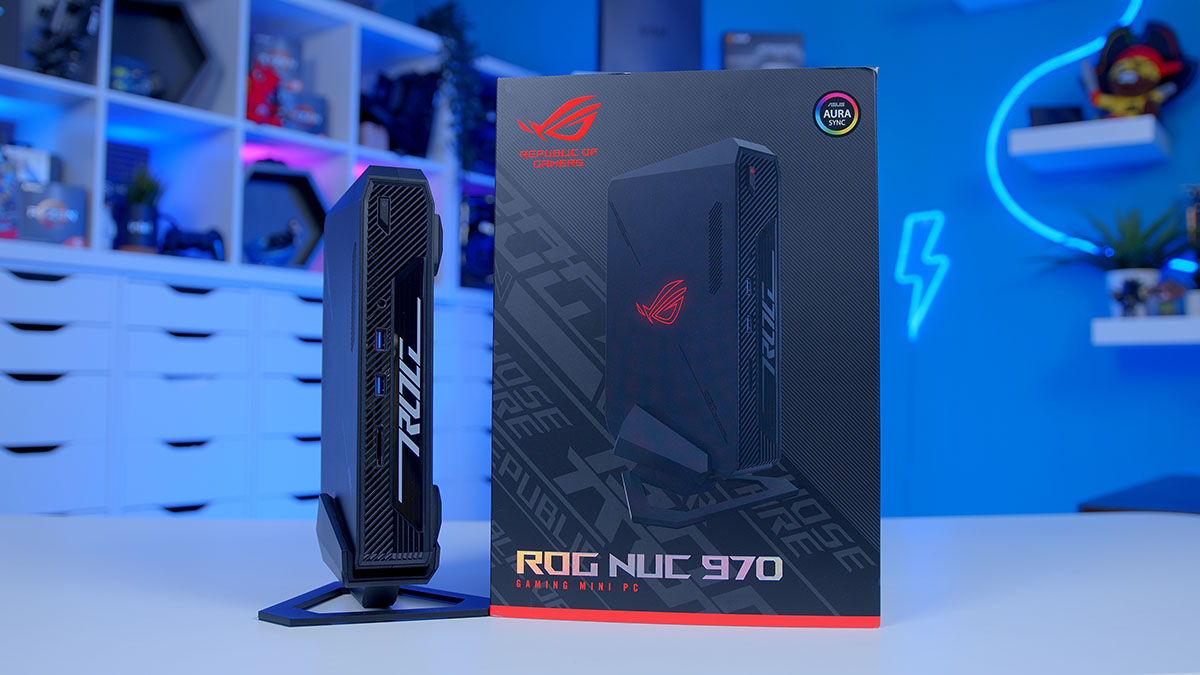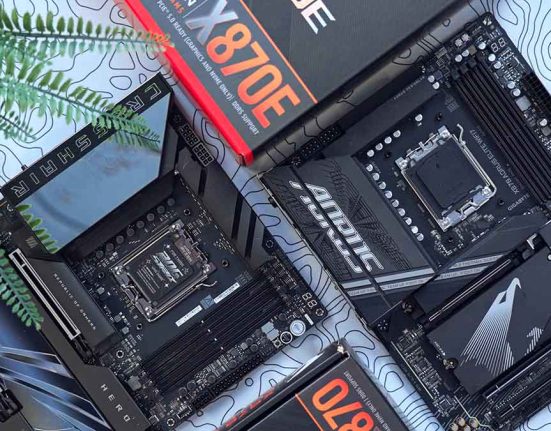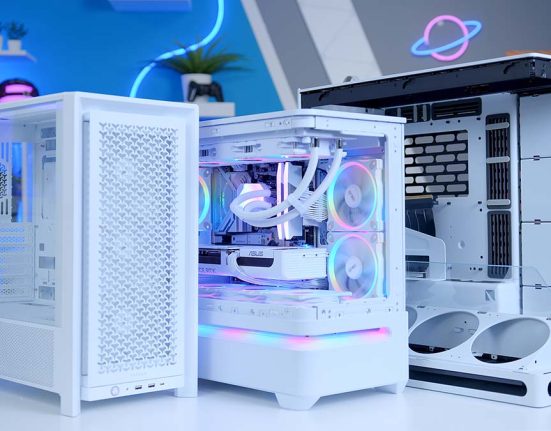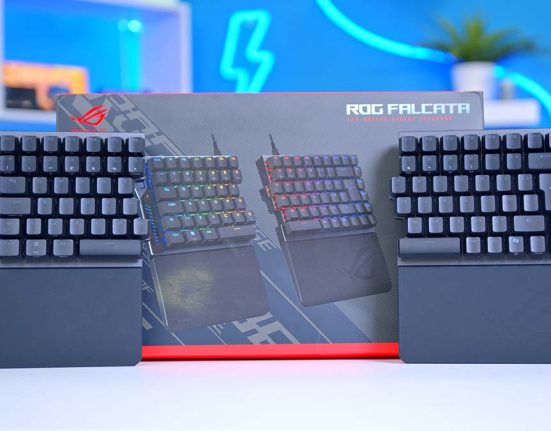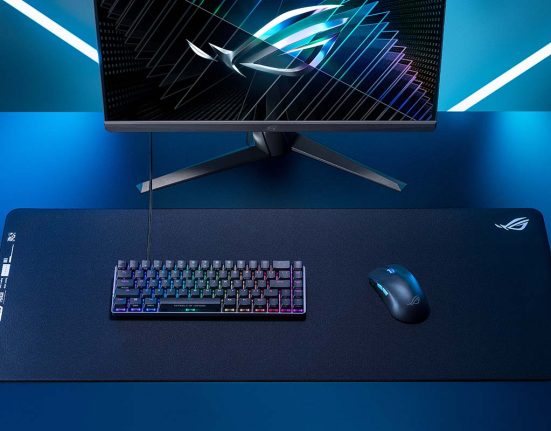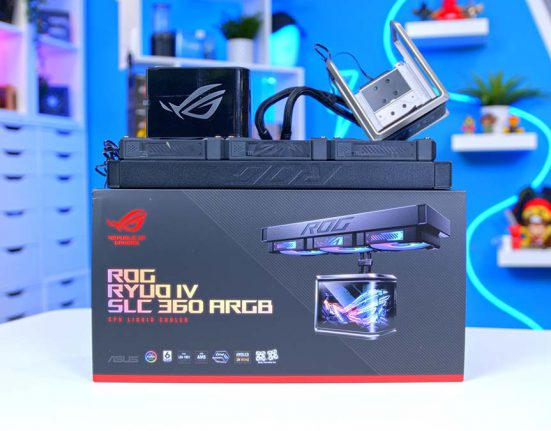The ASUS ROG NUC 907 is a compact system that acts as a small-form-factor gaming PC powered by similar hardware to most gaming laptops. Powered by an RTX 4070 laptop graphics card and an Intel Core Ultra processor, it’s designed to provide a solid gaming experience while remaining compact enough to move around, making it an excellent choice for those wanting a portable device with the functionality of a gaming PC. In this review, we’ll be testing the ASUS ROG NUC 970 in a range of gaming and desktop applications to determine whether this device can compete with other compact gaming solutions.
At one point in time, NUC (Next Unit of Computing) PCs were a hot commodity due to their compact size and improved value compared to standard desktops. Whilst their use case wasn’t necessarily for gaming, the firepower and customisation provided by these Mini-PCs made them popular in home and commercial offices. However, they slowly fell out of style, leading to Intel discontinuing support for NUCs in 2023. However, ASUS is looking to continue these devices’ legacy and repurpose them for gaming.
To find out whether the ASUS ROG NUC 970 can bring a new lease of life to these Mini-PCs, we’ll be evaluating the design in great detail while hopping into a few games to see how it compares to the performance of traditional gaming desktops, laptops, and PC gaming handhelds.
Specification
One glance at the specs table showcases the most significant difference between an NUC and a conventional desktop gaming PC. The ASUS ROG NUC 970 utilises laptop components under the hood, so we can expect performance restrictions from these components compared to their desktop alternatives.

In terms of hardware, this version of the ASUS ROG NUC 970 has an NVIDIA GeForce RTX 4070 Laptop GPU, which is best suited for 1080p or 1440p gaming. The graphics card is paired with an Intel Core Ultra 9 185H processor, leading to solid gaming performance and enough firepower to handle most applications without issues. More specifically, we’d expect this combination to deliver strong 1440p performance equivalent to a mid-range gaming PC.
The ASUS ROG NUC 970 also includes 1TB of storage and 32GB of DDR5 memory, which improves gameplay responsiveness. Whilst 2TB of storage would be ideal, 1TB is enough to install a handful of titles alongside general files and software. However, the 32GB DDR5 RAM is a welcomed inclusion.
| Key Specs | ASUS ROG NUC 970 |
|---|---|
| Dimensions (L x W x H) | 270mm x 180mm x 60mm |
| CPU | Intel Core Ultra 9 185H |
| RAM | 32GB DDR5 5600MT/s |
| Storage | 1TB PCI-E Gen4 SSD |
| Graphics Card | RTX 4070 Laptop GPU |
| Display Inputs | 2 x DisplayPort 1.4 1 x HDMI 2.1 1 x Thunderbolt 4 Type-C |
| Front IO | 2 x USB 3.2 Gen2 Type-A 1 x 3.5mm Audio Jack 1 x SD Card Reader |
| Rear IO | 2 x USB 3.2 Gen2 Type-A 2 x USB 2.0 Type-A 1 x 2.5Gb LAN |
A cheaper model is also available, which drops the CPU to an Intel Core Ultra 7 155H and GPU to the laptop version of the NVIDIA GeForce RTX 4060. Storage is also reduced to 512GB and only contains 16GB RAM. Because of this, we wouldn’t recommend this option, as the performance is significantly weaker, even if it comes in at a much lower price.
As for connectivity, the ROG NUC 970 includes various ports on both the front and back of the device, allowing you to connect plenty of displays and peripherals. The amount of connectivity is similar to what is seen on a high-end gaming laptop, with slightly more display inputs to compensate for the lack of a screen.

On the front IO, the ROG NUC 970 provides two USB 3.2 Type-A ports and a 3.5mm audio jack, making it easy to hook up a mouse, keyboard, and gaming headset. It also features an SD card reader to transfer files and media.
More USB ports can be found on the rear, with two USB 3.2 Type-A ports, two USB 2.0 ports and a Thunderbolt 4 USB Type-C, which can be used as an alternate display option. The rest of the rear IO includes two 1.4 DisplayPorts and two HDMI 2.0 ports, providing flexible display options, as well as a 2.5 Gigabit LAN port and WiFi 6E module to allow wired or wireless networking.

The main concern with the ASUS ROG NUC 970 is its pricing, as the $2,199 MSRP puts it alongside high-end gaming laptops and PCs. Whilst this is likely a result of the compact design, it is significantly pricier than alternative devices with similar hardware.
ASUS ROG NUC 970 Design
The design is arguably the main focus of the ASUS ROG NUC 970, with the system offering a small form factor which other gaming PCs simply can’t replicate. In this regard, I think ASUS have created a fantastic design with the ROG NUC 970.
Measuring 270mm x 180mm x 60mm (L x W x H), this device is very slim and compact, making it very easy to find space for within a gaming setup. The ROG NUC 970 also comes with an included stand that flips it on its side, further reducing its real-estate. For a point of comparison, the ROG NUC 970 is significantly smaller than the current generation of consoles, which is an impressive feat considering the included hardware.

However, the size isn’t the only aspect of the design that I’m a fan of, as the ROG NUC 970’s overall look is very striking. The design opts for an all-black base, with various accents and details throughout, to provide the signature ‘ASUS ROG’ look. This results in a more stealthy aesthetic on first glance, with more details appearing as you take a closer look.

The most notable feature of the ROG NUC 970 is the RGB logo on the top panel, which gives a splash of colour to this system. By default, this logo is red to match the ASUS ROG brand colours, but it can be customised with ASUS Aura Sync to match the rest of your setup.

Throughout the rest of the design, there is a heavy focus on ventilation. This system’s limited form factor means it lacks the cooling options of a conventional desktop, so lots of ventilation is required to keep components from running too hot. When positioned horizontally, many of the vents are underneath the system, which could significantly impact airflow.

That being said, the ROG NUC 970 does include rubber feet on the bottom of the design, which helps to alleviate some of these issues while preventing it from moving around on a surface. Plus, slotting it into the included stand will provide much greater airflow.
I suggest that most gamers using the ROG NUC 970 place it onto the included stand. Not only does the stand help to minimise the impact on desk space and maximise airflow, but I think it also complements the rest of the design well, completing the console-esque look.

The ROG NUC 970 comes with a power brick and cable, similar to what you would expect to see packaged with a gaming laptop. While the brick is a bit bigger than we’d hope, it will have no problems fitting into a backpack. It’s a similar story for the ROG NUC 970 itself, as the 2.6kg Mini-PC is heavier than most gaming laptops, but most people will be able to carry it around if needed.

Overall, I’m a big fan of how the ASUS ROG NUC 970 looks, and they have certainly delivered the expected size and portability of a Mini-PC. Some initial concerns with airflow will become clearer when we put this system to the test, but first impressions are strong on the design front.
ASUS ROG NUC 970 Benchmarks
To see how the ASUS ROG NUC 970 would perform, we booted it up and started running various games and workstation applications. These benchmarks provide a solid understanding of the capabilities of this system and how it would stack up to a gaming PC at a similar price point.
Our benchmarking runs focussed on 1440p performance, as these settings would provide the best balance of performance and visual fidelity. Also, most gaming monitors utilising the same hardware typically utilise a 1440p display, so this will offer a direct point of comparison for thermals and frames per second (FPS) readings.
Gaming Performance
Apex Legends
In a competitive title such as Apex Legends, we’d expect the ASUS ROG NUC 970 to be able to handle the demands of this title with ease. Our results showed a rough average of 145FPS, ideal for those hooking this system up to a 1440p 144Hz gaming monitor. This puts the graphics card in a similar position to the RX 7600 and RTX 4060 performance-wise.
Baldur’s Gate III
In Baldur’s Gate III, a slightly more CPU-intensive offering, frame rates remained stable at 1440p high settings. Throughout the majority of our testing, the game sat between 65FPS and 70FPS, with short gains and drops when transitioning between cutscenes and combat. However, CPU temperatures did spike up to 100°C at times, which raises some concerns as to how this system will cope during longer sessions.
Hogwarts Legacy
In the AAA title Hogwarts Legacy, the ROG NUC 970 managed an average of 65FPS, which is sufficient for smooth gameplay in a single-player title. On top of this, GPU and CPU temperatures remained in check throughout, with respective averages of 65°C and 80°C.
Cyberpunk 2077
We took advantage of Cyberpunk 2077’s built-in benchmarking mode to see how the ASUS ROG NUC 970 copes with the demands of a graphically demanding AAA blockbuster. Our results showed an average of 55FPS, with NVIDIA DLSS and ray tracing enabled, putting it below the 66FPS we averaged on the desktop RTX 4070.
With DLSS and ray tracing switched off, the frame rates increased to 62FPS on average, exceeding the 60FPS limit found on gaming consoles. GPU temperatures remained consistent throughout both tests, sitting around 60°C. However, CPU temps fluctuated drastically in both settings, jumping between 70°C and 100°C.
Workstation Performance
CPU-Z
Our workstation benchmarks provided some concerning insights into the ROG NUC 970’s ability to handle demanding tasks, especially regarding thermals. Throughout our multi thread benchmark in CPU-Z, the CPU temperatures remained above 100°C. Whilst laptop CPUs tend to run hotter, operating at this heat over prolonged periods is bound to cause damage over time.
Additionally, the Intel Core Ultra 9 185H scored significantly lower than the desktop Intel Core i9-13900K we used for comparison in both single and multi-threaded scenarios. In the single thread test, the Ultra 9 185H scored 687.5, over 200 points lower than the i9-13900K’s 902. Similarly, the Ultra 9 185H’s 4429.2 multi-thread score was much lower than the 16680 from the i9-13900K.
Cinebench R23
The ROG NUC 970 also failed to impress in Cenebench R23’s multi-core benchmark, sitting significantly below other notable laptop processors such as the Apple M1 Max and AMD Ryzen 7 5800X. With a score of 611 on this test, we wouldn’t recommend using this system for workstation applications, as most gaming laptops will be able to outperform it.
Features We Like
Small Form Factor
The biggest advantage of this system is its compact size, as the ROG NUC 970 is dwarfed by most desktop gaming PCs and even modern consoles. Because of this, it is a great choice for those wanting the full PC gaming experience while travelling or with a smaller gaming setup.

Included Stand
There are multiple reasons why the included stand that comes with the ASUS ROG NUC 970 is important. From an aesthetic standpoint, it provides an interesting display method which looks similar to a gaming console. However, it also leads to other benefits, such as better airflow and reduced impact on desk space. Overall, if you’re picking up this Mini-PC, I’d strongly advise using this stand.

Features We Don’t Like
Cooling & Airflow
The biggest concern from our time with the ROG NUC 970 is its thermal performance and airflow. Despite the system never feeling hot to the touch, multiple benchmarks showed CPU temperatures skyrocketing to 100°C. On top of this, it would become noisy under stressful workloads, which will be irritating if this system is close to you on a desk.

Customisation Options
One of the best aspects of the old-school NUCs is the ability to make quick changes to the inside of the systems, allowing them to become mini custom-built PCs. This feature has not actively been carried over on the ROG NUC 970, as ASUS doesn’t provide or mention any features that would enable this level of customisation. Instead, they offer a choice of two preset configurations that include significantly different hardware.

Conclusion
ASUS ROG NUC 970 Review
Product Name: ASUS ROG NUC 970
Brand: ASUS
SKU: ROG NUC 970
-
Features
-
Design
-
Performance
-
Value for Money
Summary
In concept, the ASUS ROG NUC 970 is an excellent idea that is bound to appeal to a large audience of gamers. A system that could eliminate one of the most significant downsides of PC desktops while offering a similar gaming experience and aesthetic sounds like a winning formula. However, the execution leaves a lot to be desired. With thermal issues, parts that perform significantly weaker than their desktop equivalents and a hefty price tag, the ASUS ROG NUC 970 has failed to convince me that it is better than existing compact gaming solutions.
There are some bright spots, such as the fantastic design that looks great and minimises space. But overall, the ROG NUC 970 currently caters to a very niche set of gamers who want a complete PC gaming experience that is portable, and even then, I think a Mini-ITX PC build would be a better value solution. If ASUS are serious about keeping NUCs alive, then a trip back to the drawing board is their best bet.
Pros
✅ Form factor
✅ Aesthetic
✅ Gaming performance
Cons
❌ Thermals
❌ Workstation performance
❌ Expensive


